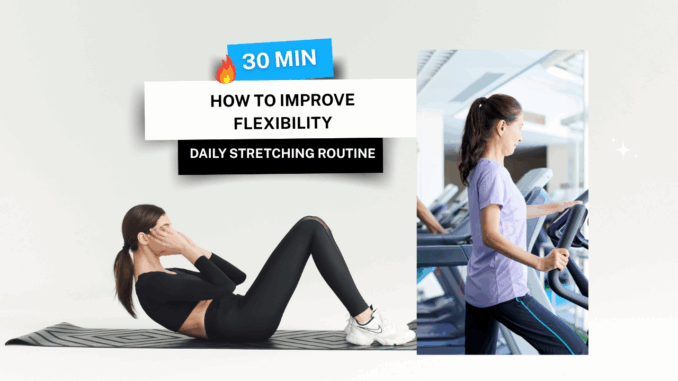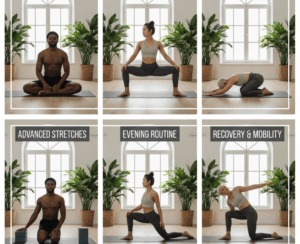
How to Improve Flexibility: A Daily Stretching Routine for Better Mobility
Do you ever feel a persistent stiffness when you wake up, struggle to reach something on a high shelf, or find yourself aching after a long day at your desk? You’re not alone. In our pursuit of fitness, many of us prioritize pounding the pavement or lifting heavy weights, often overlooking a critical component of overall well-being: flexibility. While strength and cardiovascular health are undoubtedly important, improving your flexibility is a game-changer for your physical comfort, athletic performance, and long-term health. This comprehensive guide is designed to show you how to improve flexibility through a simple yet powerful daily stretching routine for better mobility, ensuring your body can move freely, efficiently, and without pain.
Why Flexibility and Mobility Matter More Than You Think
Before diving into the “how-to,” it’s crucial to understand the distinct yet interconnected concepts of flexibility and mobility, and why they deserve your attention.
Flexibility refers to the passive range of motion in a joint. It’s how far you can move a joint with external assistance, like gravity or a partner. Think of how far your leg can stretch if you hold it up.
Mobility, on the other hand, is the active range of motion. It’s your ability to move a joint through its full range of motion under your own power, with control and strength. Having good mobility means you can execute functional movements like reaching, bending, twisting, and lifting with ease and efficiency. You can be flexible but not mobile if you lack the strength to control that range of motion.
Ignoring these aspects can lead to a cascade of negative effects, including:
- Chronic Pain: Tight muscles can pull on joints, leading to discomfort in the back, neck, and shoulders.
- Increased Injury Risk: Stiff muscles and limited range of motion make you more susceptible to strains, sprains, and tears during physical activity or even everyday tasks.
- Poor Posture: Muscle imbalances caused by inflexibility can pull your body out of alignment.
- Reduced Athletic Performance: Lack of flexibility can limit your power, speed, and efficiency in any sport or workout. You won’t be able to hit optimal positions for strength or endurance.
- Decreased Quality of Life: Simple activities like tying your shoes, getting in and out of a car, or playing with children become challenging and painful.
Conversely, embracing a routine to improve flexibility can unlock a wealth of benefits: easier daily tasks, faster recovery from workouts, significantly reduced risk of injury, enhanced athletic capabilities, and a greater sense of bodily freedom as you age. It’s an investment in your future self.

Understanding the Types of Stretching: When to Use Each
To effectively integrate stretching into your life, it’s important to know the different types and when to best utilize them. Using the right type of stretch at the right time maximizes benefits and minimizes injury risk.
1. Dynamic Stretching: Dynamic stretches involve active movements where you take your joints and muscles through their full range of motion. Unlike static stretches, you don’t hold the position; instead, you move smoothly and fluidly.
- Purpose: This type of stretching is ideal for pre-workout warm-ups. It helps to increase blood flow to the muscles, raise core body temperature, improve joint lubrication, and prepare your body for the movements it’s about to perform, reducing the risk of injury.
- Examples: Leg swings (forward/backward and side-to-side), arm circles, torso twists, walking lunges, high knees, butt kicks.
- Key takeaway: Always perform dynamic stretches before your workout or any intense physical activity when your muscles are “cold.” Never static stretch cold muscles as it can increase injury risk.
2. Static Stretching: Static stretching involves gently moving a muscle to its end range of motion and then holding that position for a sustained period, typically 20-30 seconds.
- Purpose: This is the most common type of stretching, best performed after a workout or as a dedicated flexibility session on its own. When muscles are warm, they are more pliable and responsive to lengthening. Static stretching helps to increase overall flexibility, improve range of motion, and reduce muscle soreness by promoting relaxation.
- Examples: Holding a hamstring stretch, a triceps stretch, or a quadriceps stretch.
- Key takeaway: Perform static stretches only on warm muscles. Avoid bouncing into the stretch, as this can activate the stretch reflex and cause the muscle to contract, potentially leading to injury. Aim for a gentle pull, not sharp pain.
3. PNF Stretching (Proprioceptive Neuromuscular Facilitation): PNF stretching is a more advanced technique that involves both passive stretching and isometric contractions of the target muscle. It often involves a “contract-relax” method.
- Purpose: PNF is highly effective for rapidly increasing range of motion and improving flexibility. It works by tricking the nervous system into allowing the muscle to relax more deeply.
- Examples: A common PNF hamstring stretch involves extending the leg, contracting the hamstring against resistance for a few seconds, then relaxing and stretching further.
- Key takeaway: While highly effective, PNF is often best performed with a partner or knowledgeable instructor due to its advanced nature.
Your Daily Stretching Routine for Better Mobility (10-15 Minutes)
Consistency is the absolute most critical factor when it comes to improving flexibility. Aim for a 10-15 minute routine daily, or at least 5-6 times a week. This routine is structured to address major muscle groups that commonly contribute to stiffness and limited mobility.
Part 1: Morning/Pre-Workout Dynamic Stretches (~5 minutes) Perform each movement for 30-60 seconds, or 10-15 repetitions per side. Move fluidly, increasing your range of motion gradually.
- Neck Tilts and Rolls: Gently tilt your head side to side, then slowly roll it in half-circles from shoulder to shoulder. Avoid full head circles initially if you have neck sensitivity.
- Arm Circles: Stand tall and make large circles with your arms, both forwards and backwards. Start small and gradually increase the size of the circles.
- Torso Twists: Stand with feet shoulder-width apart, arms bent at your sides. Gently twist your torso from side to side, letting your arms swing naturally.
- Leg Swings (Forward/Backward): Holding onto a wall or chair for balance, swing one leg forwards and backwards like a pendulum. Focus on controlled movement. Repeat with side-to-side leg swings.
- Walking Lunges with Torso Twist: Step forward into a lunge, and as you do, gently twist your torso towards the lead leg. This dynamically opens the hips and spine.
- Cat-Cow Stretch: On hands and knees, arch your back as you inhale (cow) and round your spine as you exhale (cat). This is excellent for spinal mobility.

Part 2: Evening/Post-Workout Static Stretches (~10 minutes) Perform these stretches when your muscles are warm, ideally after a workout or in the evening. Hold each stretch for 20-30 seconds, aiming for a gentle, comfortable pull. Repeat each stretch 2-3 times.
- Hamstring Stretch (Seated Forward Fold): Sit on the floor with legs extended. Gently hinge forward from your hips, reaching towards your toes. Keep your back relatively straight.
- Standing Quad Stretch: Stand tall, grabbing one foot with your hand and gently pulling your heel towards your glute. Keep your knees close together and chest up.
- Kneeling Hip Flexor Stretch: Kneel on one knee, with the other foot flat on the floor in front of you. Gently push your hips forward, feeling the stretch in the front of your kneeling leg’s hip.
- Figure-4 Glute Stretch: Lie on your back, bend both knees, and cross one ankle over the opposite knee. Gently pull the bottom knee towards your chest, feeling the stretch in the glute of the crossed leg.
- Calf Stretch: Stand facing a wall, place your hands on it. Step one foot back, keeping the heel down and knee straight to stretch the gastrocnemius. Then slightly bend the back knee to stretch the soleus.
- Triceps Stretch (Overhead Arm Extension): Reach one arm overhead, bend the elbow, and let your hand drop behind your head. Use your other hand to gently push the elbow down, stretching the triceps.
- Chest Opener (Doorway Stretch): Stand in a doorway, place your forearms on the frame with elbows bent. Gently lean forward, opening up your chest and shoulders.
- Child’s Pose: A restorative stretch. Kneel on the floor, sit back on your heels, and fold your torso forward, resting your forehead on the ground. Reach arms forward or back by your feet.
READ ALSO 24 Hour Fitness: Your Guide to Late-Night and Early-Morning Workouts
Key Principles for Effective Stretching
To make your flexibility journey safe and effective, keep these principles in mind:
- Consistency is Crucial: Infrequent, long stretching sessions are far less effective than shorter, daily routines. Like brushing your teeth, make it a habit.
- Listen to Your Body: Stretching should never be painful. You should feel a gentle pull or tension, not sharp, searing pain. If it hurts, ease off.
- Breathe Deeply: Your breath is a powerful tool. Inhale deeply, and as you exhale, try to relax into the stretch a little further. Holding your breath tenses your muscles.
- Stay Hydrated: Water plays a crucial role in muscle elasticity and joint lubrication. Ensure you’re drinking enough fluids throughout the day.
- Warm Up First (for static stretches): As mentioned, never static stretch cold muscles. A brisk walk or a few minutes of light cardio will prepare your muscles for lengthening.
- Proper Form Over Depth: Focus on executing each stretch correctly. Incorrect form can lead to injury or simply negate the benefits. If unsure, watch videos or consult a professional.

Integrating Flexibility into Your Lifestyle
Making flexibility a priority doesn’t always mean a dedicated block of time. You can weave it into your day:
- Micro-Stretches: Take short stretch breaks at your desk every hour. Simple neck rolls, shoulder shrugs, or gentle torso twists can make a difference.
- After Workouts: Make your cool-down stretches non-negotiable. Your muscles are already warm and receptive.
- Morning Routine: Start your day with 5-10 minutes of gentle dynamic movements to wake up your body.
- Before Bed: A few static stretches in the evening can help relax your muscles and mind, potentially leading to better sleep.
- Consider Structured Classes: Yoga and Pilates are excellent ways to explore deeper flexibility, mobility, and body awareness under expert guidance.
Conclusion
Embracing a daily stretching routine for better mobility is one of the most impactful investments you can make in your physical health. It’s not about becoming a contortionist; it’s about reclaiming your body’s natural capacity for movement, preventing pain, enhancing performance, and enjoying a higher quality of life. Start small, be consistent, and listen to your body. Even a few minutes each day will yield noticeable improvements. Your journey to improve flexibility begins now – and your body will thank you for it.

Leave a Reply